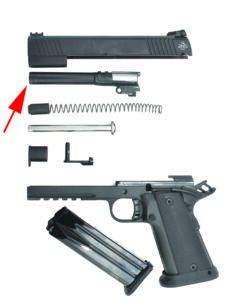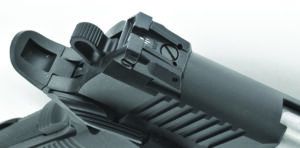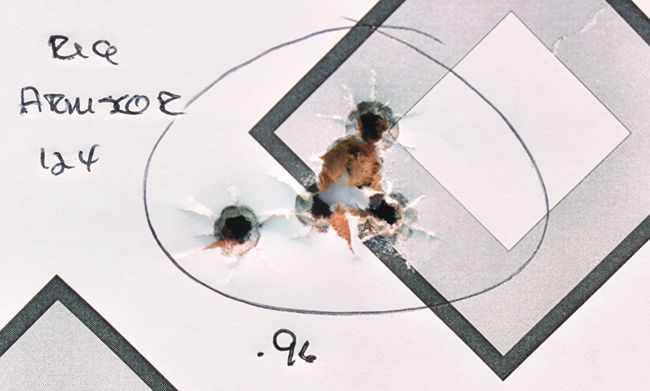Several 9mm models with double-stack magazines have really caught our eye recently. The first came from a new company called Cosaint. Our sample was a high-capacity COS21 with a Commander-length slide, an Officer’s Model–length barrel, and a bit of a compensator. It runs $2600. The next piece came from Rock Island Armory, the Model M1911 A2 FS-Tactical, $774. It uses a slightly older design, but it is built with modern production methods and comes in at an incredible price point. The third was the Springfield Armory Prodigy, $1650. Boasting features similar to other 2011-style pistols, the Prodigy gun itself is similar to a pistol we tested in the August 2023 issue, but this one was a package that comes with a Hex Dragonfly red dot, whereas the August gun was shot exclusively with a Crimson Trace CTS-1250. Because the Hex was a factory-installed optic, we wondered if it would improve the Prodigy’s downrange results beyond what the Crimson Trace dot could do.
This trio looks and feels like a 1911-style handgun, with one major difference. A 1911 in 45 ACP is a great pairing, but a standard magazine only holds seven rounds. Switching to a 9mm chambering adds a couple more rounds, but in this age of high-capacity 9mms, we want more than that.
Two Canadian gentlemen, Ted Szabo and Thanos Polyzos, brought us a great solution to the capacity problem at Para-Ordnance in the mid-1980s, with a 1911 top end mated to a double-stack-magazine-capable grip frame. The first generation of Para-Ord double-stack 1911s was bit large, but edges were rounded and bulk was trimmed, making the 2nd Gen a much more usable pistol. Also, STI (now Staccato) provided a major step in the evolution of the platform with a stainless-steel frame attached to a polymer grip module, and the 2011 was born.
Modern iterations retain the most important characteristics of Browning’s classic 1911 design, such as the 18-degree grip angle, superb trigger, and greatly improved sights, along with high-capacity magazines. Our three test guns in 9mm Luger have all these features. To see how they performed, we tested with 115-grain FMJ fodder from Winchester and Remington and a 124-grain FMJ round from Armscor. Our fourth round was a defensive choice, Hornady’s Critical Duty 124-grain +P. Function was perfect for all three of the pistols tested. We did not have a single malfunction in more than 1200 rounds fired. Here’s more on how they did.
Gun Tests Grade: B+ (BEST BUY)
$774
Owned and operated by the Tuason family, Rock Island Armory/Armscor has done business out of the Philippines for many decades. During this time, they have become the most prodigious producer of 1911-style firearms in the world. They opened their first office in the states in 1985. Now, with facilities in Nevada, Utah, and Montana, RIA/Armscor continues its inroads into the American market. Known for their innovation with products such as the 22 TCM cartridge, the STK 100 pistol, and their recent RIA 5.0, Rock Island Armory has become a force to be reckoned with. Rock Island has long had a reputation for producing quality products at a great price. Wanting to cover the gamut of prices while we tested “fat frame” 1911s, we secured a sample of the RIA M1911 A2 FS-Tactical. We found street pricing for it under $800 and soon found that we had a pistol with more than $800 worth of features in it.
| Action Type | Semi auto, hammer fired |
| Overall Length | 8.5 in. |
| Overall Height | 5.75 in. |
| Maximum Width | 1.53 in. at magwell |
| Weight Unloaded | 2.96 lbs. |
| Weight Loaded | 3.6 lbs. |
| Slide | 4160 steel |
| Slide Retraction Effort | 13.5 lbs. |
| Receiver | 4160 steel, Picatinny rail |
| Finish | Parkerized |
| Front Strap Height | 3.0 in. |
| Back Strap Height | 3.5 in. |
| Barrel Length | 5.0 in. |
| Grip Thickness (Maximum) | 1.43 in. |
| Grip Circumference | 5.9 in. |
| Magazines | Two 18 round |
| Rear Sight | LPA Adjustable |
| Front Sight | Red fiber optic in dovetail |
| Sight Radius | 6.5 in. |
| Trigger Pull Weight | 3.3 lbs. |
| Trigger Span | 2.9 in. |
| Safeties | Thumb levers and Grip |
| Warranty | Limited |
| Telephone | (775) 537-1444 |
| Website | Armscor.com |
| Made In | The Philippines |
In contrast to the lightweight Springfield Armory Prodigy and the even more feathery Cosaint COS21, the RIA FS-Tactical is all beef. The 5.0-inch barrel may be standard diameter, but the slide and frame are both full-profile solid-steel components. No lightening cuts, no alloys, no tapered noses, just 4140 ordnance steel. Weight, consequently, is a good bit heavier than its stable mates for this test. The RIA is about three-quarters pound heavier than Springfield’s Prodigy and well over a pound more than the Cosaint. Is that a problem? Depends on what you are trying to do. For those who need something light to carry all day, every day, it might be an issue. For those with an aversion to recoil or an intended usage where the pistol isn’t toted around on a belt, weight can be an absolute blessing.

Elsewhere, the FS-Tactical has many features we expect to see on a good 1911. The barrel has been fitted nicely and barely moves when we press on the hood. It has a fully supported chamber and a nicely polished feed ramp. The slide allows just enough movement for function but has very little side-to-side play. Cocking serrations have been milled front and rear.
Like on the other pistols, the RIA has a good example of a skeletonized trigger that worked well. Required compression was 3.3 pounds, with everything nice and crisp. Note that those carved-out triggers are not just decorative, because 1911 triggers bounce around under recoil. The lighter the triggers are, the lighter the return spring can be set against it, thereby contributing to an overall lighter trigger pull.
The RIA is not optics ready, instead presenting a good red-fiber-optic front sight and an adjustable LPA rear sight. We noticed that, like the Springfield and the Cosaint, the RIA did not include a firing-pin safety. The firing-pin safety was declared a must-have in the 1980s when folks discovered the firing pin could light off a cartridge in the chamber if a 1911 was dropped directly on its nose from enough height. Linkages were engineered that would prevent movement of the firing pin unless the trigger was also properly depressed. The result was, perhaps, improved safety, along with a heavy, sometimes gritty trigger. Many have since learned that a lightweight firing pin and a heavy firing pin spring can accomplish much the same thing with less degradation of the trigger pull. As we understand it, removing all those Series 80 parts made it much easier to machine a 1911-style pistol for optical sights. The RIA does not have optical sights, and what it does have should suffice quite nicely for most applications. However, should you so desire, a good machinist could mill the slide to accept an optic of your choice. We wouldn’t do that to this gun, but it could probably be done. We mentioned Para-Ordnance earlier, and this pistol reminds us very much of a second-generation Para frame. The edges of the front strap have been rounded off from the squared first-gen style. The trigger guard has been undercut a bit to allow a higher grip. The beavertail safety has been blended in nicely, and a good ambi-safety has been installed. Even the mainspring housing is steel, and this one has been checkered at 20 lines per inch, per our best guess. A large steel magazine well vacuumed up every mag we threw in its direction. The magwell can easily be removed if so desired. Hex-head grip screws held thin G10 grip panels tightly in place against the frame.

The Para-Ordnance models of 30+ years ago tended to have feeding problems in which the second or third round would nose down into the feed ramp instead of the chamber. At the time, we would rip the magazine apart and change out springs, modify feed angles on the follower, and more. Eventually we got those pistols to run like a house afire. Part of the problem was that we were all trying to feed a heavy stack of 45 ACP cartridges at warp speed. The 9mm rounds this RIA is chambered for did not create the same challenge. In fact, this Rock Island pistol ran like a champ straight out of the box.
The LPA sights provided a great sight picture, while they provided secure and precise adjustment of point of impact. All that steel served to mitigate muzzle flip extremely well, making the RIA very comfortable to shoot. That weight also made it a bit more difficult to move. We noticed that our first shots from the holster for the Rock Island were a bit slower than the other two, though the splits (times between shots) were essentially the same. If muzzle velocity is of primary importance to you, the full 5-inch barrel on the Rock Island provided the highest speeds, especially with the hottest rounds. For example, the RIA clocked more than 125 fps faster with the Hornady 124-grain +P Critical Duty than did the Cosaint.
Our Team Said: While the Springfield Prodigy and the Cosaint were designed to be used with optical sights, the Rock Island FS-Tactical was built around a great set of adjustable iron sights, and it showed. For its accuracy and function, this is a Best Buy.
9mm Luger Range Data
Our shooters fired these pistols at American Shooting Centers in Houston. We shot them for accuracy at 15 yards by firing multiple five-shot groups from a sandbagged Caldwell Pistol Rest and a Mini DRC Fortune Cookie from Wiebad.com. We used a LabRadar chronograph to measure velocities.
| Remington 115-grain FMJ | Springfield Prodigy | Cosaint COS21 Commander | Rock Island Armory FS-Tactical |
| Average Velocity | 1147 fps | 1128 fps | 1196 fps |
| Muzzle Energy | 336 ft.-lbs. | 325 ft.-lbs. | 365 ft.-lbs. |
| Best Group | 1.49 in. | 1.52 in. | 1.07 in. |
| Average Group | 1.73 in. | 1.79 in. | 1.46 in. |
| Winchester 115-grain FMJ | Springfield Prodigy | Cosaint COS21 Commander | Rock Island Armory FS-Tactical |
| Average Velocity | 1104 fps | 1062 fps | 1159 fps |
| Muzzle Energy | 311 ft.-lbs. | 288 ft.-lbs. | 343 ft.-lbs. |
| Best Group | 1.47 in. | 1.20 in. | 1.10 in. |
| Average Group | 1.97 in. | 1.45 in. | 1.38 in. |
| Armscor 124-grain FMJ | Springfield Prodigy | Cosaint COS21 Commander | Rock Island Armory FS-Tactical |
| Average Velocity | 1060 fps | 1026 fps | 1071 fps |
| Muzzle Energy | 309 ft.-lbs. | 290 ft.-lbs. | 316 ft.-lbs. |
| Best Group | 1.73 in. | 1.50 in. | 0.96 in. |
| Average Group | 1.96 in. | 1.83 in. | 1.33 in. |
| Hornady | Springfield | Cosaint | Rock Island Armory |
| 124-grain Critical Duty | Prodigy | COS21 Commander | FS-Tactical |
| Average Velocity | 1177 fps | 1095 fps | 1223 fps |
| Muzzle Energy | 382 ft.-lbs. | 330 ft.-lbs. | 412 ft.-lbs. |
| Best Group | 0.79 in. | 1.44 in. | 1.46 in. |
| Average Group | 1.43 in. | 1.66 in. | 1.49 in. |
Drill Data (5x5x5)
Process: Fire five shots from draw at a 5-inch circle placed at 5 yards. Numbers are averages for two repetitions.| Pistol | Time to First Shot (seconds) | Split Average (seconds) | Total Time (seconds) |
|---|---|---|---|
| Springfield Prodigy | 1.36 | 0.20 | 2.160 |
| Cosaint COS21 Commander | 1.395 | 0.230 | 2.310 |
| Rock Island FS-Tactical | 1.570 | 0.264 | 2.625 |
Drill Data (5x7, A ZONE)
Process: Fire five shots from draw at A-zone plate (5-by-11 inches) at 7 yards. Numbers are averages for two repetitions.| Pistol | Time to First Shot (seconds) | Split Average (seconds) | Total Time (seconds) |
|---|---|---|---|
| Springfield Prodigy (irons) | 1.335 | 0.1990 | 2.13 |
| Springfield Prodigy (red dot) | 1.2 | 0.201 | 2.005 |
| Cosaint COS21 Commander | 1.255 | 0.205 | 2.075 |
| Rock Island FS-Tactical | 1.380 | 0.204 | 2.195 |
DRILL DATA (5x8, A ZONE)
Process: Fire five shots from draw at A-zone plate (5-by-11 inches) at 8 yards. Average of five draws from holster.| Pistol | Total Time (seconds) |
|---|---|
| Springfield Prodigy (irons) | 1.210 |
| Springfield Prodigy (red dot) | 1.298 |
| Cosaint COS21 Commander | 1.238 |
| Rock Island FS-Tactical | 1.342 |




























